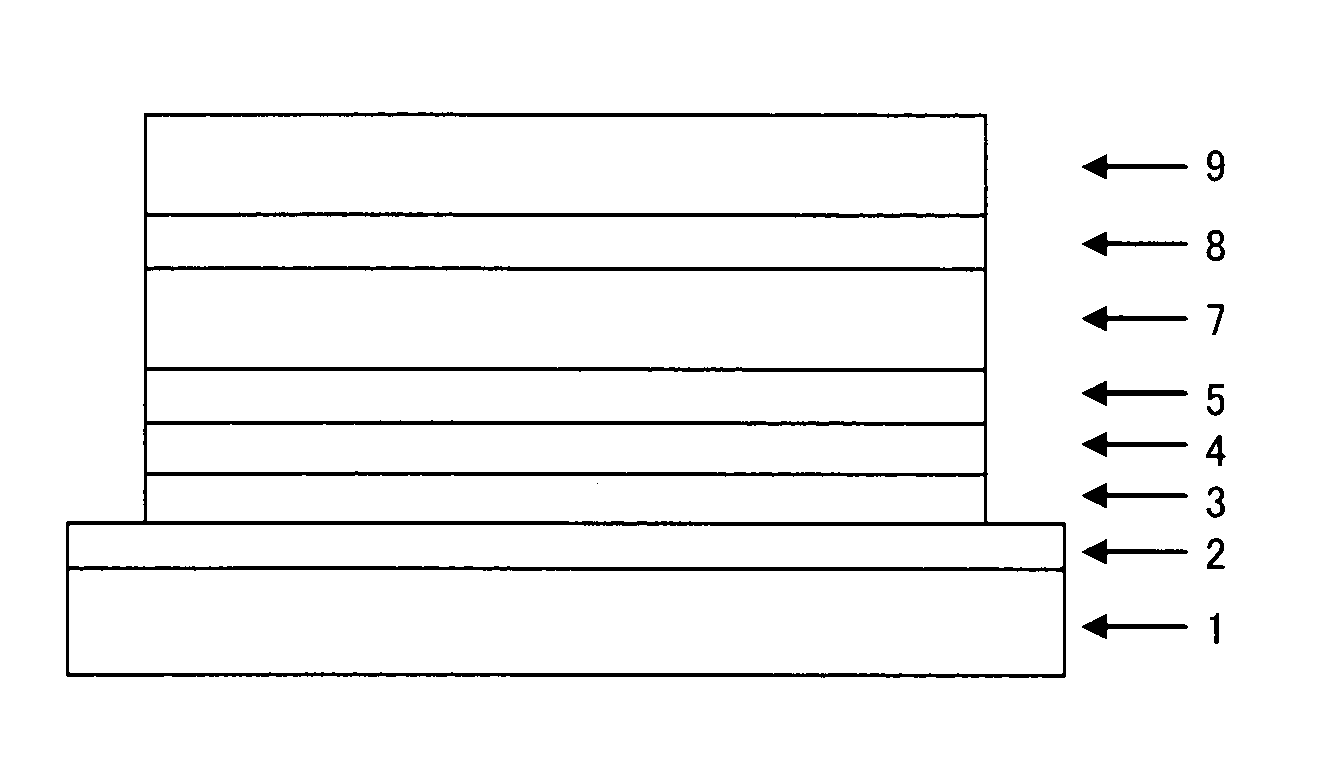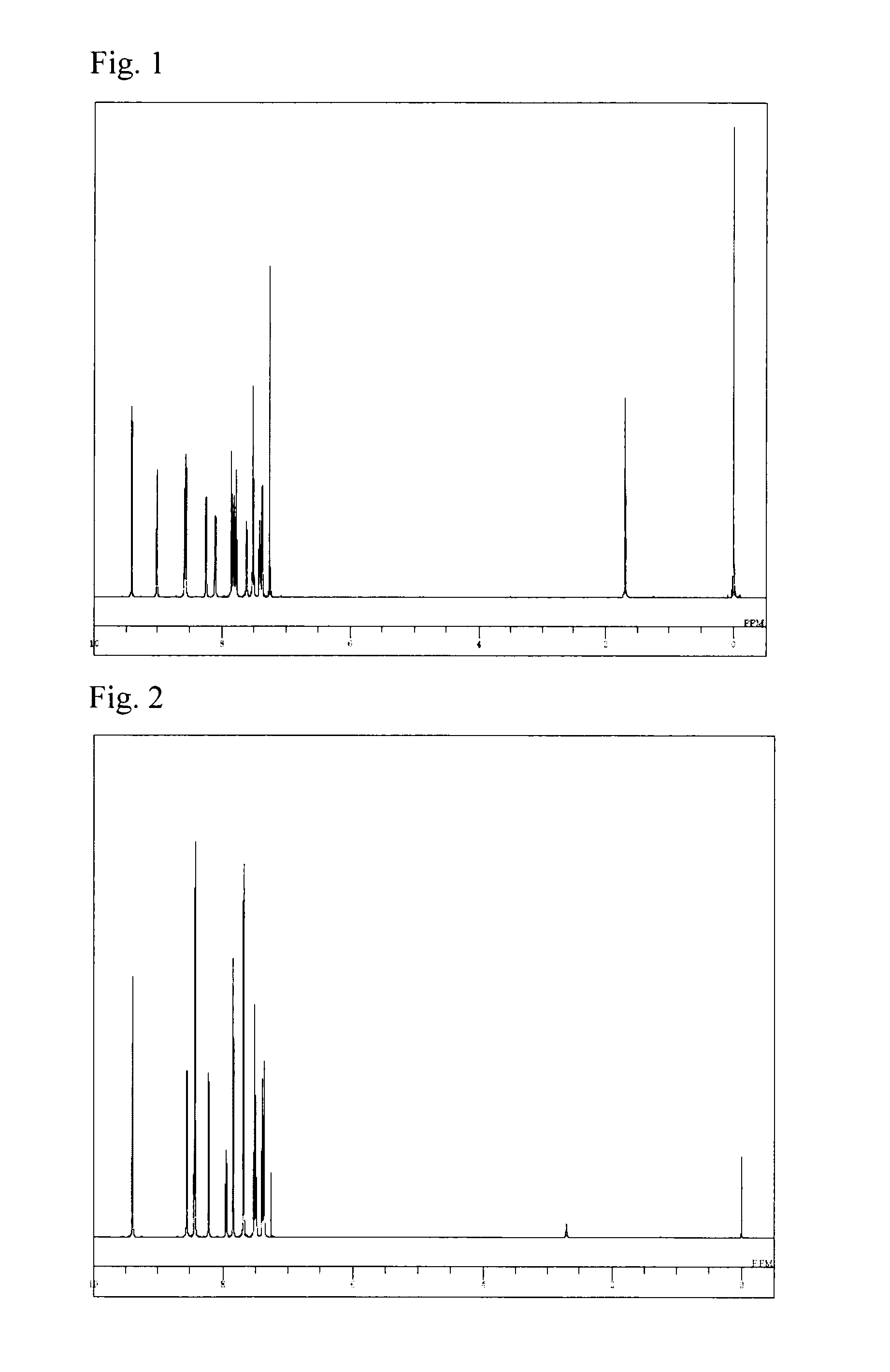Compound having substituted pyridyl group and pyridoindole ring structure linked through phenylene group, and organic electroluminescent device
a technology of pyridoindole and pyridyl group, which is applied in the direction of thermoelectric devices, discharge tube luminescent screens, natural mineral layered products, etc., can solve the problems of low electron transport properties, reduce efficiency, and cannot consider the capability of hole-blocking materials, etc., to achieve excellent hole-blocking ability, excellent thermal resistance, and high luminous efficiency
- Summary
- Abstract
- Description
- Claims
- Application Information
AI Technical Summary
Benefits of technology
Problems solved by technology
Method used
Image
Examples
example 1
(Synthesis of 5,5′-bis[3-(5H-pyrido[4,3-b]indol-5-yl)phenyl]-[2,2′]bipyridine (Compound 99))
[0064]A reaction vessel was charged with 6.0 g of 2,5-dibromopyridine, 7.0 ml of bistributyltin, and 120 ml of xylene, followed by heating and stirring at 60° C. for 15 minutes. Further, 700 mg of tetrakis(triphenylphosphine)palladium was added thereto, followed by stirring at 120° C. for 8 hours. After cooling to room temperature, the insoluble materials were removed by filtration, and the filtrate was washed with 150 ml of an aqueous ethylenediamine tetraacetate solution. The organic layer was dehydrated with anhydrous sodium sulfate and concentrated under reduced pressure to obtain a crude product. The crude product was purified by column chromatography (carrier: silica gel, eluent: cyclohexane / toluene) to obtain 1.7 g (yield 42%) of 5,5′-dibromo-[2,2′]bipyridine as a yellow powder.
[0065]Another reaction vessel was charged with 17.2 ml of 1,3-dibromobenzene, 6.0 g of 5H-pyrido[4,3-b]indole...
example 2
(Synthesis of 2,6-bis[4-(5H-pyrido[4,3-b]indol-5-yl)phenyl]pyridine (Compound 126))
[0070]As in Example 1,5-(4-bromophenyl)-5H-pyrido[4,3-b]indole was synthesized from 1,4-dibromobenzene and 5H-pyrido[4,3-b]indole, and further subjected to a reaction with bis(pinacolato)diborone to synthesize 5-[4-(4,4,5,5-tetramethyl-[1,3,2]dioxaborolan-2-yl)phenyl]-5H-pyrido[4,3-b]indole. To 5.0 g of the resulting 5-[4-(4,4,5,5-tetramethyl-[1,3,2]dioxaborolan-2-yl])phenyl]-5H-pyrido[4,3-b]indole were added 1.6 g of 2,6-dibromopyridine, 0.39 g of tetrakis(triphenyl phosphine)palladium, 16.9 ml of a 2 M aqueous potassium carbonate solution, 56 ml of toluene, and 14 ml of ethanol, followed by heating with reflux while stirring for 8.5 hours. After cooling to room temperature, 50 ml of toluene and 100 ml of water were added thereto to separate the liquid and collect the organic layer. Further, the aqueous layer was extracted with 70 ml of toluene. The organic layers were combined, dehydrated with anhyd...
example 3
[0073]For the compounds of the invention, melting point and glass transition point were determined by means of a highly sensitive differential scanning calorimeter (DSC 3100S manufactured by Bruker AXS).
Melting PointGlass Transition PointCompound of Invention352° C.138° C.Example 1Compound of Invention283° C.134° C.Example 2
[0074]The compounds of the invention show a glass transition point of 100° C. or higher, and thus are stable in a thin-film state.
PUM
| Property | Measurement | Unit |
|---|---|---|
| voltage | aaaaa | aaaaa |
| luminance | aaaaa | aaaaa |
| work function | aaaaa | aaaaa |
Abstract
Description
Claims
Application Information
 Login to View More
Login to View More - R&D
- Intellectual Property
- Life Sciences
- Materials
- Tech Scout
- Unparalleled Data Quality
- Higher Quality Content
- 60% Fewer Hallucinations
Browse by: Latest US Patents, China's latest patents, Technical Efficacy Thesaurus, Application Domain, Technology Topic, Popular Technical Reports.
© 2025 PatSnap. All rights reserved.Legal|Privacy policy|Modern Slavery Act Transparency Statement|Sitemap|About US| Contact US: help@patsnap.com



